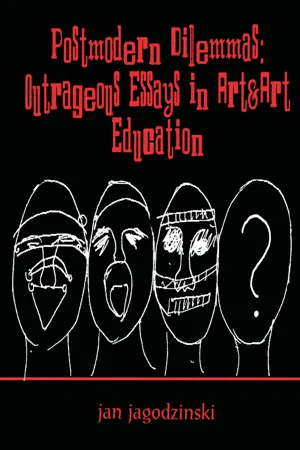
- 286 pages
- English
- ePUB (mobile friendly)
- Available on iOS & Android
About This Book
In Postmodern Dilemmas: Outrageous Essays in Art&Art Education and Pun(k) Deconstruction: Experimental Writings in Art&Art Education, jan jagodzinski presents a series of essays covering a timespan of approximately ten years. These essays chart the theory and practice of art&art education as it relates to issues of postmodernity and poststructuralism concerning representation, identity politics, consumerism, postmodern architecture, ecology, phallocentrism of the artistic canon, pluriculturalism, media and technology, and AIDS. As a former editor of The Journal of Social Theory in Art Education and a founding member for the Caucus on Social Theory in Art Education, the author attempts to deconstruct the current art education paradigm, which is largely based on modernist tenets, and to reorient art education practice to social issues as developed in both media education and cultural studies. Part of the intent in these two volumes is to undertake a sustained critique of the 1982 Art in the Mainstream (A.I.M.) statement, which continues to be considered as the core value for art education. The distinct intention of this critique is to put forward a new value base for art&art education in these postmodern times.Many of the essays raise the need to be attentive to sex/gender issues in art&art education and the need to read the artistic discourse "otherwise." There is a sustained critique of the art programs developed by the Getty Center for the Arts, whose arts curriculum presents the paradigm case of late modernist thinking. Some essays are written in a provocative form that tries to accommodate such content. This is particularly the case in Pun(k) Deconstruction, where architectural discourse is deconstructed, and which includes an "artistic performance" given by the author in 1987. This singular set of volumes combines scholarship in the areas of gender studies, aesthetics, art history, art education, poststructuralism, and cultural studies in a unique blend of theory and practice for rethinking the field of art education.
Frequently asked questions
Information
SECTION II
Talking Back
4
a
Para/critical/sitical/sightical
Reading
Ralph Smith's
Excellence in Art Education1
(1987)
—Baudelaire
Disclaimer:
Pretext
“Bad Theater”
IN-THE-NAME-OF-THE-FATHER2: BEARDSLEY, GOODMAN, REID, OSBORNE
At the O(R)FFICE
Table of contents
- Cover
- Half Title
- Series Title
- Title
- Copyright
- Dedication
- Contents
- Preface
- SECTION I: ART EDUCATION IN A POSTMODERN AGE
- SECTION II: TALKING BACK!
- Bibliography
- Author Index
- Subject Index